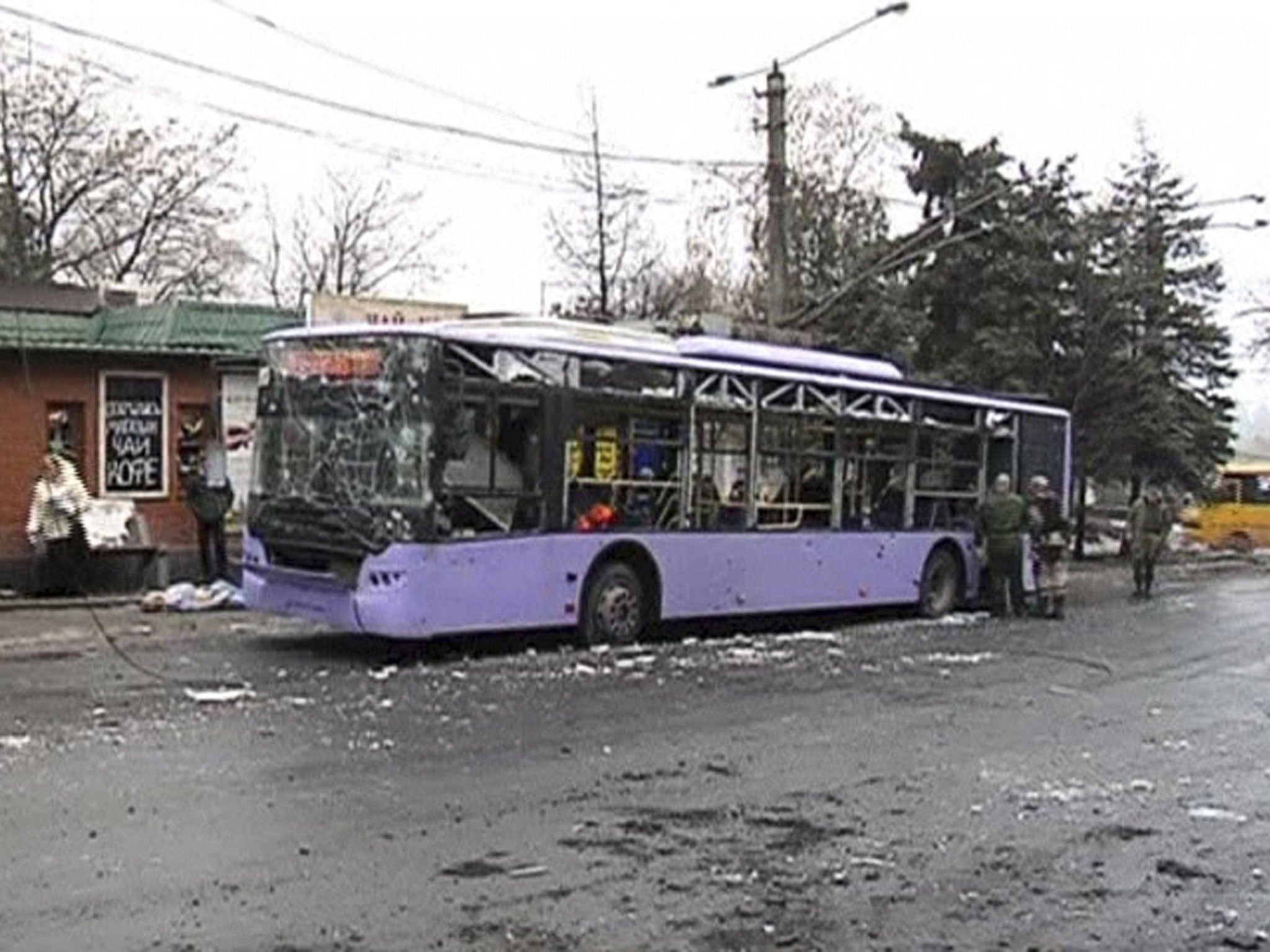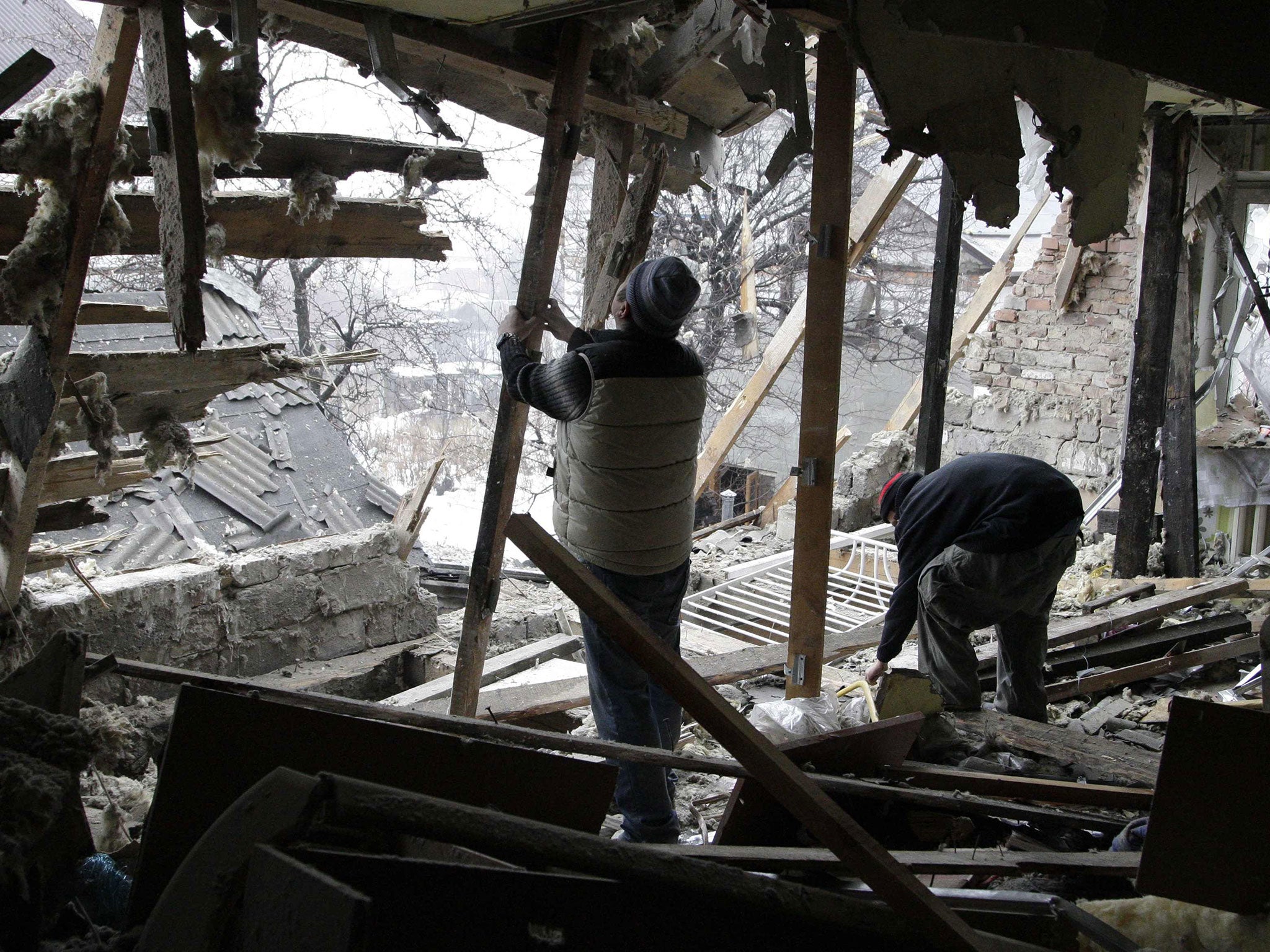Ukraine crisis: Violence returns to Donetsk as 13 people are killed during shelling of bus in rebel-held city
The ceasefire is in tatters following atrocity that could have been the work of rebels or pro-Ukrainian partisans, and troops pull out of airport after prolonged fighting

Your support helps us to tell the story
From reproductive rights to climate change to Big Tech, The Independent is on the ground when the story is developing. Whether it's investigating the financials of Elon Musk's pro-Trump PAC or producing our latest documentary, 'The A Word', which shines a light on the American women fighting for reproductive rights, we know how important it is to parse out the facts from the messaging.
At such a critical moment in US history, we need reporters on the ground. Your donation allows us to keep sending journalists to speak to both sides of the story.
The Independent is trusted by Americans across the entire political spectrum. And unlike many other quality news outlets, we choose not to lock Americans out of our reporting and analysis with paywalls. We believe quality journalism should be available to everyone, paid for by those who can afford it.
Your support makes all the difference.Commuters were waiting to travel to work. The tram and bus terminal in Kuprina Street, south Donetsk, was busy. Some had boarded a waiting bus when, at around 9.30am today, missiles fell from the sky, killing 13 people and injuring another 20.
“Here I am, cleaning up blood and brains, and they have the nerve to call us terrorists,” cried Irina Petrovna, 52, as she held up a blue bucket after the shelling in Ukraine’s troubled east.
The event served as the latest reminder of how December’s uneasy truce has broken down and given way to full-scale hostilities. It came eight days after a civilian bus was shelled while waiting at a Ukrainian checkpoint on the Mariupol-Donetsk highway.
Over the last week, Donetsk city centre has become largely deserted after dark. The thunder of artillery is commonplace. Fighting has been concentrated in the districts nearest Donetsk’s ruined airport, located six miles to the north of the city. But shelling has in recent days also reached central streets. Donetsk airport has become a symbolic Stalingrad, with stakes high for both sides. Without the airport, Russian-backed rebel forces were unable to claim control of the city. For the Ukrainians, the loss of the airport would represent a big moral and strategic defeat, with possible consequences for Ukrainian sovereignty in other cities.
Over the last week there have been various versions as to the situation at the airport, with each side claiming full control. On Wednesday, however, Kiev appeared to admit defeat by stating it was concentrating on holding positions around neighbouring villages. The military spokesman Vladislav Seleznyov said government forces had withdrawn. “We left the new terminal because it looks like a sieve and there’s simply nowhere to hide there,” he said.
The Independent was on several occasions able to speak to “Slavik”, the nom de guerre of a 22-year-old Ukrainian paratrooper serving in the 80th brigade. Last weekend, Slavik said he was one of a number of Ukrainian soldiers still in the airport’s new terminal. He was nervous, explaining that rebel forces had encircled the unit, that Ukrainian artillery was providing “insufficient” cover, and that they were experiencing heavy bombardment.
Slavik said he could see a number of soldiers on the floor – “some dead, some injured”. Ukrainian forces had not been able to create a corridor to evacuate the seriously injured, he added. By Monday this week, The Independent was unable to reach Slavik. At some point during the course of the day, the new terminal building was bombed by rebel forces, crushing the Ukrainian soldiers that remained inside. Many were killed in the explosion, and others remained trapped under the rubble.

Speaking to The Independent on Wednesday, the Ukrainian negotiator Vladimir Ruban revealed that he was in discussions to allow access to the terminal to remove trapped soldiers who, he said, were dying from injuries.
Later that day, rebel forces released videos showing they had captured 11 Ukrainian soldiers from the airport, including Slavik. Today he was at the front of a column of war prisoners, brought to the scene of the Kuprina Street bus explosion for a public parade of disgrace.
Locals who had gathered for the parade were shouting insults, spitting and on occasion striking the prisoners. The rebel military escort did little to impede them from doing so.
Much confusion remains as to who, or what, was behind the bus attack. Craters at the scene suggested they were consistent with shorter-range, high-trajectory missiles. Rebel authorities at the scene also put forward a mortar theory, contending that they had been launched by pro-Ukrainian partisan groups from within the city.
At the same time, the rebel leader Alexander Zakharchenko declared there had been artillery strikes in the area, and a rebel representative claimed a 152mm howitzer had landed in a factory alongside the bus terminal.
Near one of the residential blocks to have been hit in recent shelling, 25 Prospekt Mira, there were two craters. Vyacheslav Saransky, who was at home at the time, says that the missiles landed at 8.15am, and that two residents had been hospitalised.
An American military specialist who saw photographs of the damage said he believed it was probably caused by “a 120mm mortar, of type 2B11”. The most common variant of this mortar munition is the so-called Sani (Sleigh), developed by the Soviet Union in 1981. The maximum range of such missiles is 4.7 miles, less than the nearest known Ukrainian military position.
Whichever way this attack is interpreted – as evidence of rebels shooting their own, or of pro-Ukrainian partisans operating within the city – it is certain to radicalise both sides further.
“If the enemy does not want to keep the ceasefire, we will kick them in the teeth”, said Ukraine’s President Petro Poroshenko.
Join our commenting forum
Join thought-provoking conversations, follow other Independent readers and see their replies
Comments